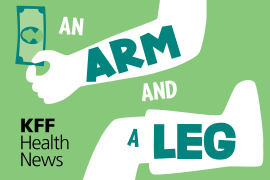The Brutal, Decade-Long Fight To Get This Small, Straightforward Drug Pricing Bill Passed
Read about the biggest pharmaceutical development and pricing stories from the past week in KHN's Prescription Drug Watch roundup.
Stat:
Washington Took A Decade To Approve An Obscure Drug-Pricing Bill. That’s A Bad Omen For More Ambitious Reforms
After a grueling, decadelong fight, President Trump last month signed a new law that aims to help lower drug prices — the first substantial piece of legislation on that issue that’s made it to his desk. But the bill’s yearslong struggle to make it to the president’s desk highlights a jarring reality in Washington: Even when a drug pricing bill is relatively straightforward and bolstered by broad bipartisan support, even when hospitals, insurers, doctors and patient groups all back it, even when nearly everyone in Washington wants to lower drug prices, it takes years to get anything done. (Florko, 1/7)
The Baltimore Sun:
Priceless Cure For Maryland Baby Cost $2.1 Million, But Insurer Paid — And Now She’s Expected To Live
Four-month-old Ainsley Cardente smiles, enjoys “helicopter” rides from her mom and protests when lunch is late. Perfectly ordinary, all of it. And her life is expected to remain that way thanks to a $2.1 million drug recently infused into her little body by doctors from Johns Hopkins Hospital. Ainsley was born with a rare genetic disorder called spinal muscular atrophy, or SMA, that kills most babies by age 2. Rarely, there are less severe versions like the one that afflicts Ainsley that lead to a slower but still catastrophic decline. (Cohn, 1/3)
The Wall Street Journal:
Deep Genomics Gathers $40 Million For AI-Based Drug Discovery
Deep Genomics Inc. has raised $40 million in venture capital to put treatments discovered through its artificial intelligence-based drug-discovery platform to the test in human studies. Several biotechnology startups aim to use artificial intelligence to speed the discovery of new medicines. They include Recursion Pharmaceuticals Inc., which secured $121 million in July 2019 to expand its machine learning-enabled drug-discovery platform and progress a pipeline of drugs. (Gormley, 1/7)
Stat:
Apellis Pharmaceuticals’ Drug Candidate Outperforms Alexion’s Soliris In A Clinical Trial Comparing The Two
Apellis Pharmaceuticals revealed data from a late-stage clinical trial on Tuesday showing its experimental drug candidate appears to treat a rare blood condition better than a blockbuster Alexion drug. The drug candidate, known as pegcetacoplan, takes aim at a genetic disease known as paroxysmal nocturnal hemoglobinuria, or PNH. People with the condition are missing certain protective proteins on red blood cells that would otherwise prevent their immune systems from attacking the cells. About 5,000 Americans have the condition. (Sheridan, 1/7)
Health News Florida:
Bill Would Allow Vending Machines For Prescription Drugs
The automated pharmacy systems would operate like vending machines for prescription drugs. The machines wouldn't have to be located at a pharmacy so they could be placed in areas where access to medications is limited. And the kiosks could operate 24-hours a day, 7 days a week, according to HB 59 sponsor, Rep. Matt Willhite, a Palm Beach Democrat. (Ochoa, 1/6)
The CT Mirror:
Blumenthal Says Lilly's Lispro Is A 'Bait And Switch' Insulin For Diabetics
Last March, under political pressure to cut the price of the life-saving drug, Eli Lilly pledged to distribute a generic form of its brand name, $300-per-vial insulin drug, Humalog, at half the price. At the end of the year, Blumenthal, D-Conn., and Warren, D-Mass., found that Lispro was not available in 83% of the pharmacies surveyed and many pharmacists were unaware of, or not adequately informing their customers, about the availability of the lower-cost Lispro. (Radelat, 1/3)
Stat:
3 Drug Pricing Policy Experiments To Watch In 2020
Politicians spent the better part of 2019 bickering over the best way to lower drug prices. But in the meantime, states, advocates — even the drug and insurance industries — were devising novel strategies for solving this perplexing challenge. 2020 will be the year many of those experimental ideas are tested. If they pan out, they’ll undoubtedly be models for other states or companies — and perhaps serve as inspiration for Washington, too. Below, STAT looks at three of the most interesting ideas. (Florko, 1/2)
Stat:
The VA Approach To Buying Drugs Means Patients Are Less Likely To Skip Medications Due To Cost
As U.S. policy makers grapple with ways to widen access to medicines, a new study suggests that a model used by the Department of Veterans Affairs could improve patient adherence and presumably lower health care costs. To wit, patients who obtain prescription drugs from the Veterans Health Administration were less likely than other insured Americans to skip doses or medicines altogether. They were also less likely to delay filling prescriptions because they were unable to afford them. Moreover, the VA system appeared to reduce racial and economic disparities in accessing medicines. (Silverman, 1/6)
The Wall Street Journal:
Drug Prices Climb By 5.8% On Average, Less Than Last Year
Pharmaceutical companies started 2020 by raising the prices of hundreds of drugs an average of 5.8%, according to a new analysis, a smaller increase than a year prior as the industry faces growing scrutiny from patients, lawmakers and health plans. Pfizer Inc. led the way, including increasing prices by over 9% on more than 40 products. The drug industry traditionally sets prices for its therapies at the start of the year and again in the middle of the year. (Hopkins, 1/2)
The Wall Street Journal:
Antibiotic Makers Struggle, Hurting War On Superbugs
The world desperately needs new antibiotics to tackle the rising threat of drug-resistant superbugs, but there is little reward for doing so. Instead, the companies that have stepped up to the challenge are going bust. Makers of newly approved antibiotic drugs are struggling to generate sales because doctors prescribe the treatments sparingly. The new drugs compete with older, cheaper products, and patients typically take them for only a week or two at a time. (Roland, 1/5)






